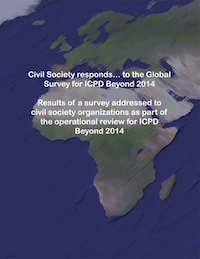 Civil society organizations (CSOs) have launched their responses to the Global Survey, the results of which are included in the Framework of Actions for the follow-up to the Programme of Action of the International Conference on Population and Development Beyond 2014.
Civil society organizations (CSOs) have launched their responses to the Global Survey, the results of which are included in the Framework of Actions for the follow-up to the Programme of Action of the International Conference on Population and Development Beyond 2014.
While Governments were asked to involve CSOs and youth groups in the completion of the Global Survey for the ICPD Beyond 2014 Operational Review, in many cases this did not happen. It was therefore decided that a survey would be carried out addressed specifically to CSOs and youth groups.
To allow comparisons with government perceptions, the Civil Society Survey used the same areas and population groups as the Government Survey and replies were compiled using the same coding system. However, CSOs were asked to give one priority, whereas governments were asked to give up to five priorities. Where CSOs did give more than one priority, only the first one was included in the analysis. Furthermore, responses were only taken where CSOs worked on the issues concerned with the majority working on issues related to women, gender-based violence, reproductive health, HIV/AIDS, youth development and LGBT issues. Although in replying CSOs were asked to identify neglected areas as well as priorities, only priorities were analyzed as both areas tended to be very similar.
Responses analyzed from three regions
In total, 453 fully completed responses were received with 258, the majority, coming from the Americas. A further 80 replies were received from Africa and 59 from Europe. There were only 46 and ten replies from Asia and Oceania respectively, which was not considered representative and were therefore not included in the analysis.
Key findings
Interaction between population dynamics and sustainable development
In all three regions CSOs stated that health and education are most important for population dynamics and sustainable development, with many specifying sexual and reproductive health and family planning. The next highest priority was social sustainability.
Needs of specific population groups -- youth; ageing and older persons; addressing persons with disabilities; and indigenous peoples
Sexual and reproductive health information, education and services was the main priority for adolescents and youth in the Americas and Africa, while education, followed by comprehensive sexuality education, was the priority for Europe. Preventive and curative health care was the main concern for older persons in Latin America and Africa and programmes for the support of the elderly and social inclusion was highlighted in Europe. Social inclusion and rights was the main priority both for persons with disabilities and indigenous peoples.
Urbanization and internal migration
Social protection was the highest priority for both Latin America and Europe, with Africa considering it as its second priority, with the quality of urban life being the first priority. This was also a strong concern for Latin America.
International migration and development
There was a very strong call for social inclusion and rights from both Latin America and Africa. Both these regions also identified social protection as important. The major concern for Europe, on the other hand was for the development of programmes, policies, strategies, laws/creation of institutions pertaining to international migration.
Family, well-being of individuals and societies
The Americas identified family diversity as most important, while Africa highlighted health care, also the second priority for the Americas. For Europe the priority was education.
Reproductive rights and reproductive health, morbidity and mortality
The concern of greatest importance for the Americas was abortion, followed by social inclusion, which was the highest priority for Europe, and comprehensive sexuality education. For Africa the most important priority was the development of programmes, policies, strategies, laws/creation of institutions, followed by targeted sexual and reproductive health for adolescents and youth.
Gender equality, equity and empowerment of women and gender –based violence
The CSO Survey deviated from the topics of the Government Survey in the area od gender equality, equity and empowerment of women insofar as a separate question was asked on gender-based violence, which is a major concern for many CSOs. The responses have therefore been analysed separately. Social inclusion and rights was the primary concern for CSOs in the Americas and was the second priority for those in Africa, who identified gender norms and male engagement as their highest priority. For Europe, economic empowerment, employment and participation was most important. Addressing violence in particular, the Americas identified the development of programmes, policies, strategies, laws/creation of institutions, while both Africa and Europe stressed the various forms of violence. As a second priority Africa highlighted gender norms and male involvement.
Population, development and education
The inclusion of sexual and reproductive health/comprehensive sexuality education was the main priority for population, development and education was the priority for both the Americas and Europe. For Africa the main priority was quality standards. In addition, the Americas and Africa considered social inclusion and rights as their second priority.
For further information please contact: Doris Mpoumou (International Planned Parenthood Federation – Western Hemisphere Region); Bia Galli (Ipas); or Marianne Haslegrave (Commonwealth Medical Trust).